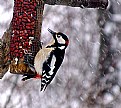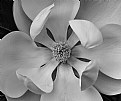|
|
 John Melskens
{K:-5433} 9/2/2007
John Melskens
{K:-5433} 9/2/2007
|
Yes, Nick, you are right.
|
|
|
|
 Nick Karagiaouroglou
Nick Karagiaouroglou
 {K:127263} 9/1/2007
{K:127263} 9/1/2007
|
Pixelation/grain, when brought intentionally into the look of an image, is a style element. But unfortunately not when brought by incidense when, say, working on some image with some software. I love grain too, and I did post many images that were very grainy. But it has to be connected to intention for creating some special style. And it has also to integrate well with that style, which in many digital alterations is not the case, as it appears only in some regions of the image, that then look more like patches than anything else.
And so, as you said, it is much better to have the correct settings for the very intention, which seems to be the A and O of photographic work. (And which I am still learning! ;-))
All the best,
Nick
|
|
|
|
 John Melskens
{K:-5433} 8/30/2007
John Melskens
{K:-5433} 8/30/2007
|
Nick - I am just a simple photographer and not even a pro anymore.
what you say is that working on digital images allmost allways brings worsening in some aspect of the photo.
Algorithms are not my cup of tea. I guess I know what they are, but I am not even sure.
Pixelation seeme the biggest problem when working on a digital image. Well, not te me.
In B&W photography we allmost allways had GRAIN. To me that is the same as pixalation. So, some pixalation is okay with me. I have no problem with that.
In areas where there was no detail in your photo now pixalation showed up. I agree.
I guess the only real solution is to take photos with a very correct exposure.
Greetings, John
|
|
|
|
 Nick Karagiaouroglou
Nick Karagiaouroglou
 {K:127263} 8/30/2007
{K:127263} 8/30/2007
|
And I do appreciate your work, John, as I do of course open my mind about it to you.
As always, when dealing with the numberous possibilities of afterwards alteration of images, be brightening, darkening, or whatever else, care has to be taken that the image won't go cabloy.
So, this is a hard question to me about that. It seems that most of the bettering of some aspects of the image does also bring some worsening in some other aspects. I still don't know of any way to avoid those side effects. Perhaps there isn't any way and we just have to live with compromises? (Or perhaps I am asking for too much?)
The lengthy anylysis of the brightening - if unwished jump to the next paragraph.
-----------------------------------
The alteration itself did make the whole image brighter, but it also instructed the software to "discover" afterwards details on regions of the image (the remarked regions) where no detail was available due to underexposure. You know, multiplying 0 with an arbitrary (not infinitely) big number will result in 0. Multiplying a set of small numbers with the same arbitrarily big number will enforce the differences of luminocity of adjucent pixels and thus pixelation. So the software replaced those regions with rather random-like pixel noise, since the brightening algorithms won't converge evenly for all the pixels of that region because of the already mentioned expected set-numerical instabilities there - a very unwished phenomenon but also unavoidable. And so my question could be translated into: Is such a numerical instability really unavoidable? There are only empirical but not really analytical facts for that. Imagine what would happen though, if somebody would discover some algorithm that doesn't go insane at such regions. Your alteration would be perfect then! (Sigh!)
-----------------------------------
But your alteration can still be taken as a partial hint, something like photographical reverse engineering, that says: "Stronger exposure would make it brighter this way, avoiding the pixelation on the remarked places." And as such it is very valuable. Not as a bettering of the image, but indeed very helpful to me as a hint for increasing my limited know-how. And for that I do thank you very very much.
Best wishes,
Nick
|
|
|
|
 John Melskens
{K:-5433} 8/29/2007
John Melskens
{K:-5433} 8/29/2007
|
Nick - I just tried to make the picture a little brighter, NOT better.
But your calibration is good and you like your picture the way it is.
Very good.
All the best to you too,
John
|
|
|
|
 Nick Karagiaouroglou
Nick Karagiaouroglou
 {K:127263} 8/29/2007
{K:127263} 8/29/2007
|
Thanks a lot for the nice comment, Dave! I think more and more that the branches are OK, too.
Best wishes,
Nick
|
|
|
|
 Nick Karagiaouroglou
Nick Karagiaouroglou
 {K:127263} 8/29/2007
{K:127263} 8/29/2007
|
Thank you very much, Claudia!
Nick
|
|
|
|
 Nick Karagiaouroglou
Nick Karagiaouroglou
 {K:127263} 8/29/2007
{K:127263} 8/29/2007
|
Thanks a lot for your replies and advices, John! I did calibrate my screen since the Mac does carry such tools onboard, but I might still have calibrated with some errors included, so it's always a good thing to compare some image's look even from the distance. The original image is not too dark to me, and that's why I asked you to perhaps mark some regions of it that appear too dark to you. This way I could see better if there is some error in my calibration, or if we simply differ in judging. In general I do like low-keyish street images very much, and that's of course why I post them.
Thanks a lot also for your work on altering the image, which I can really only take as fooling around with it, as you said, since... you virtually destroyed it. :-( Look at the pixelation in the remarked regions of the attachment, and judge for yourself. It wouldn't stand any serious critiques this way.
In general, low key photography does have the aim to present some darker atmosphere "under pressure", and this is bought (naturally) at the price of a darker look. Whether we like it or not is up to ourselves, of course, but such artificially introduced artefacts just out of the wish to bring some image's luminance to regions that we like more, are inacceptable.
All the best,
Nick
|

Problematic regions in John's work on the original |
|
|
|
 Dave Stacey
Dave Stacey
 {K:150877} 8/28/2007
{K:150877} 8/28/2007
|
I like the composition of this corner shot, Nick! The branches don't bother me, I think they add to the atmosphere of a tree lined street.
Dave.
|
|
|
|
 Claudia Perilli
{K:31090} 8/28/2007
Claudia Perilli
{K:31090} 8/28/2007
|
Nice street, great BW.
Claudia
|
|
|
|
 John Melskens
{K:-5433} 8/28/2007
John Melskens
{K:-5433} 8/28/2007
|
Nick - I have fooled around with your picture to show you that it can be done - a brighter photo.
Maybe you like it, maybe you don't.
Let me know what you think.
John
|

|
|
|
|
 John Melskens
{K:-5433} 8/28/2007
John Melskens
{K:-5433} 8/28/2007
|
Hi Nick - if someone would say to me "your pictures look very dark in the shadows" I would look for a program on the internet to calibrate my own computer-screen first. Because you have to be able to judge your own photos first. You have to like your pictures!
If your pictures are too dark TO YOU, then you have to work with a good program like Photoshop or PSP to do something about it.
Good luck!
John
|
|
|
|
 Nick Karagiaouroglou
Nick Karagiaouroglou
 {K:127263} 8/28/2007
{K:127263} 8/28/2007
|
Thanks a lot, Marcelo!
Nick
|
|
|
|
 Nick Karagiaouroglou
Nick Karagiaouroglou
 {K:127263} 8/28/2007
{K:127263} 8/28/2007
|
Thanks a lot for the suggestion and the comment, John! Could you clarify to me where the shadows are too dark, just for helping me making some conclusions about my screen? (Damned color management, you see!)
Best wishes,
Nick
|
|
|
|
 Nick Karagiaouroglou
Nick Karagiaouroglou
 {K:127263} 8/28/2007
{K:127263} 8/28/2007
|
Grazie molto per il commento piacevole, Simone!
Nick
|
|
|
|
 Marcelo Berraz
{K:12906} 8/28/2007
Marcelo Berraz
{K:12906} 8/28/2007
|
Very good Nick amigo!!M.
|
|
|
|
 John Melskens
{K:-5433} 8/28/2007
John Melskens
{K:-5433} 8/28/2007
|
Keep the branches - they fill the picture on the left. And that is okay. You shadows seem very dark to me, but that is maybe just my screen.
|
|
|
|
 Simone Tagliaferri
{K:28180} 8/28/2007
Simone Tagliaferri
{K:28180} 8/28/2007
|
Bella inquadratura e ottimo bianco e nero.
|
|
















